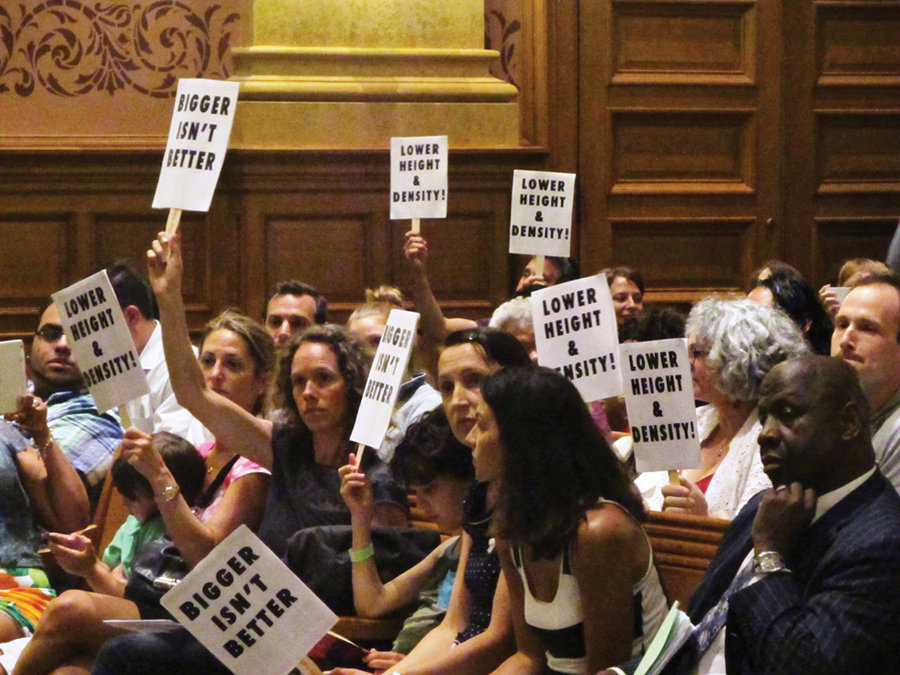Not all of the dozens of people who spoke out at the June 25 City Council meeting objected to the redevelopment plan for the Unico Towers site in downtown Jersey City, but many did, angrily telling the council that the construction of a residential project 50 feet above the current zoning guidelines would change the nature of one of the most historic parts of Jersey City.
Most of the residents of the Hamilton Park neighborhood said the new 400-unit 190-foot tower, called Marin Residence and proposed by developer KRE, did not fit in with the neighborhood .They said it should be scaled back to a the maximum 250 units and 140 foot of the tallest existing building in the area.
Located near Manila Drive, the redevelopment site is on the very eastern edge of the Hamilton Park area. It’s within sight of the historic park, but also bordering Newport Mall and the crop of high rise buildings along the waterfront.
The Hamilton Park neighborhood is largely bounded by Marin Boulevard on the East, the Sixth Street Embankment on the north, Jersey City Heights on the west, and the approach to the Holland Tunnel on the south. It is a neighborhood largely made up of historic brownstones that edge up to each side of the four-square-block park. People stroll the park, walk their dogs along these streets, often pausing at local cafes, while as many walk across Manila Avenue to commute to New York via the Newport area PATH train.
“We love our neighborhood and don’t want buildings of that height and density.” — Kirsten Greene
____________
In proposing the redevelopment, city officials hoped to encourage the development of a property that has largely lain fallow for years. They do not see the property as encroaching on Hamilton Park, but rather blending into the vibrant skyscape of the Newport area, and possibly serving as anchor for future development along this same narrow north/south corridor.
Public response
Kirsten Greene, one of the leading critics of the project, said the proposed tower could end up being only 100 feet from historic structures, and that even senior citizens next door hadn’t been aware of how large and dense the project would be.
“I understand the density is profitable, but it should be more in line with the character of the neighborhood,” she said.
She also said the larger the project, the deeper the drilling, and the more risk there is to historic structures nearby. She said quality of life would be affected, not to mention the impact on parking.
“Hamilton Park has a sense of community,” she said. “We love our neighborhood and don’t want buildings of that height and density.”
Many of the other residents agreed, and pointed to successful smaller projects such as those by Silverman that transformed the old St. Francis Hospital. They suggested that if KRE wants Newport-like structures that the project should be constructed in Newport, not Hamilton Park.
But some residents said the development of other housing was needed in the area.
Katie Brennan, and urban planner, said many young urban professionals want to move into the Hamilton Park area, but cannot afford the high cost of brownstones.
“These units will be priced for people like me,” she said. But she suggested that it might be possible to negotiate with the developer for slightly lower density and height.
A wasteland between neighborhoods
Matt Shapiro said that when he moved into the area in 1998, the property was fenced in, but almost never used; and some felt it was unsafe. He called it “a pedestrian wasteland,” and supported the redevelopment that would bring a new building with new retail, new restaurants, and a public park.
“This is nearly a full city block from any of the low rise buildings,” he said, and it was right on the edge of Marin Boulevard.”
Shapiro said the zoning laws that restrict height and density were for development in the 1970s and no longer valid considering recent development in that area.
But Peter Bowers said the 19-story building will negatively affect people in the community, and will set a tone for future development.
Eric Fleming, president of the Harsimus Cove Association, which borders the Hamilton Park neighborhood, said this building has no place in the historic neighborhood.
Where more than two dozen people spoke mostly against the project, Council President Ronaldo Lavarro said that Councilwoman Osborne – who was not at the meeting – had taken a survey and found that most residents of the area were not opposed.
The ordinance passed with a 7 to 1 vote, with Councilman Michael Yun voting against it.
Al Sullivan may be reached at asullivan@hudsonreporter.com.
